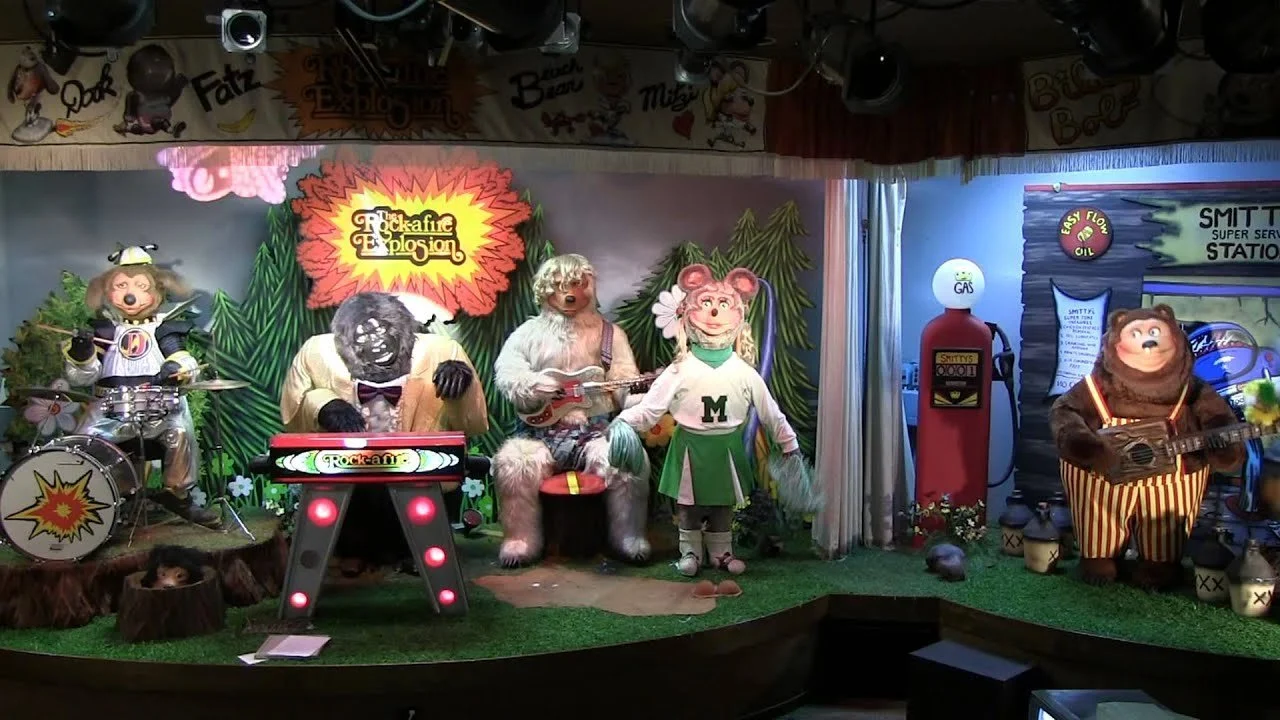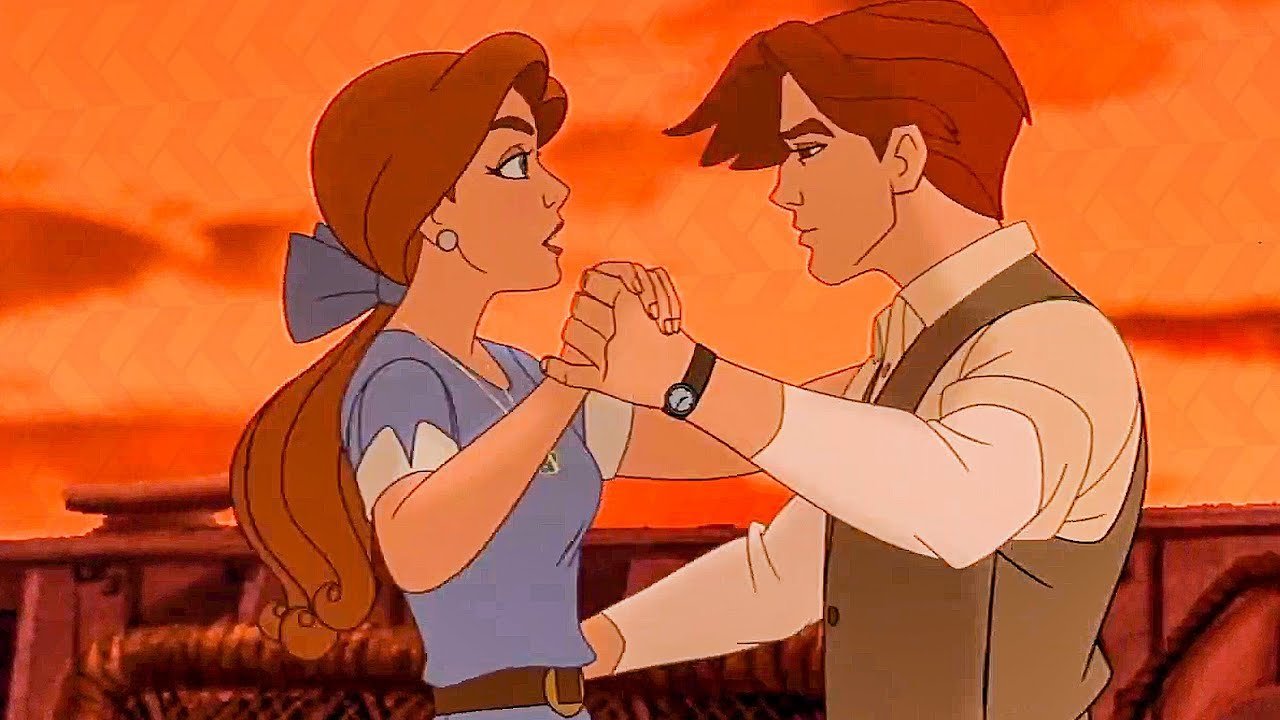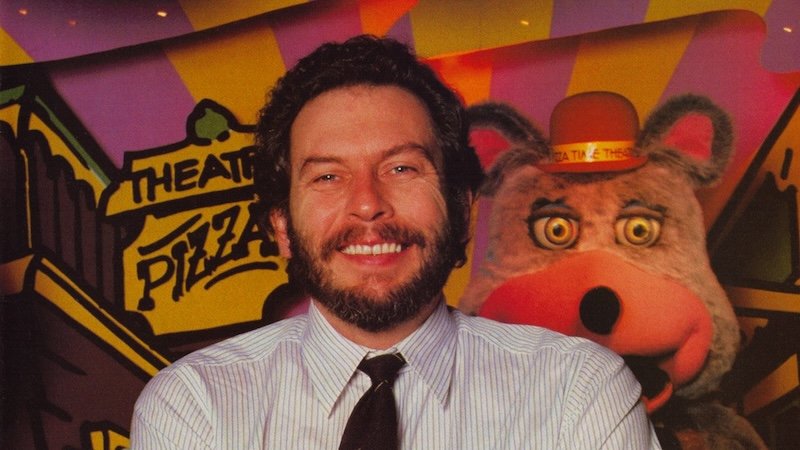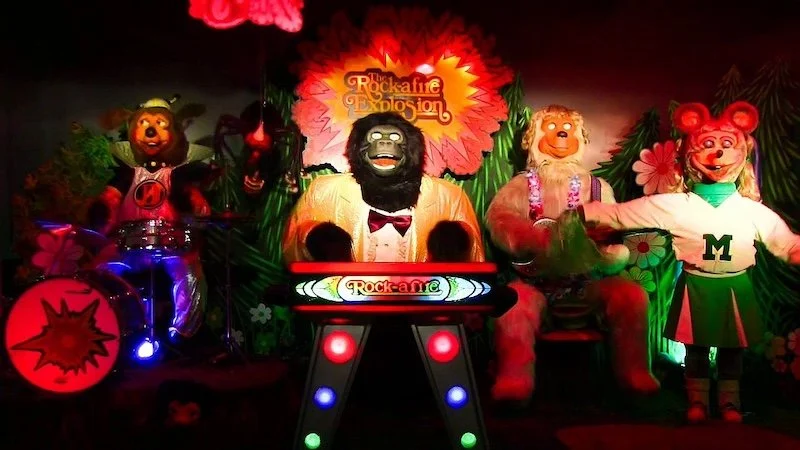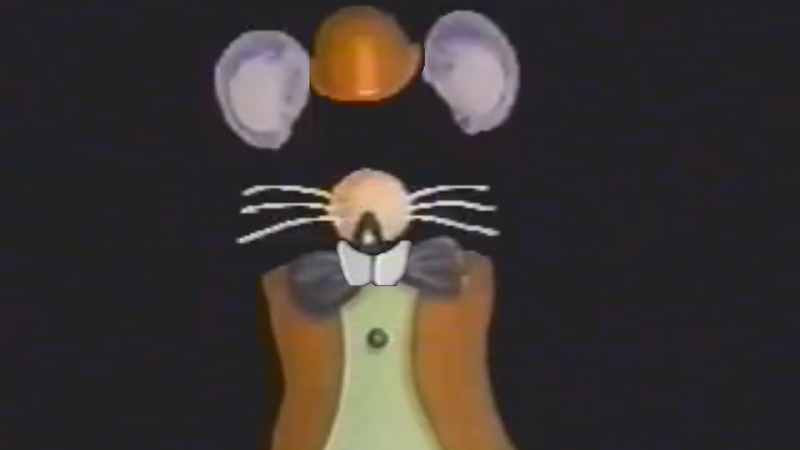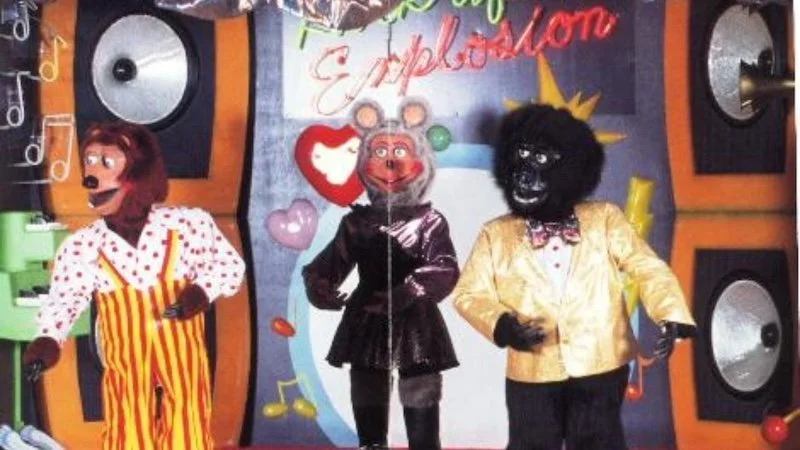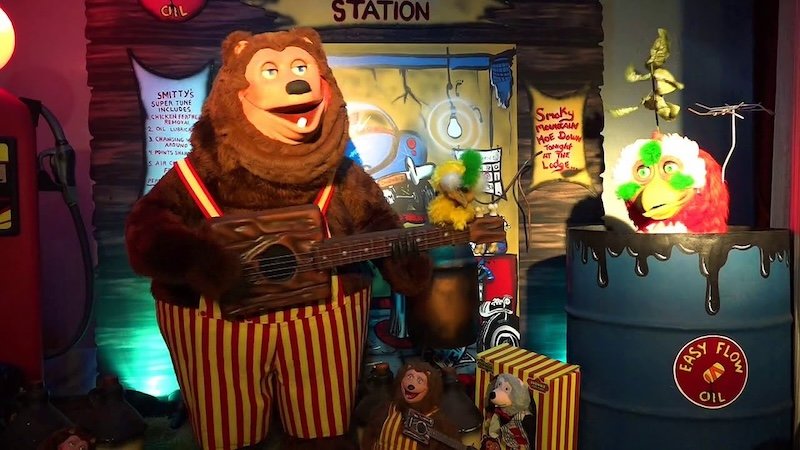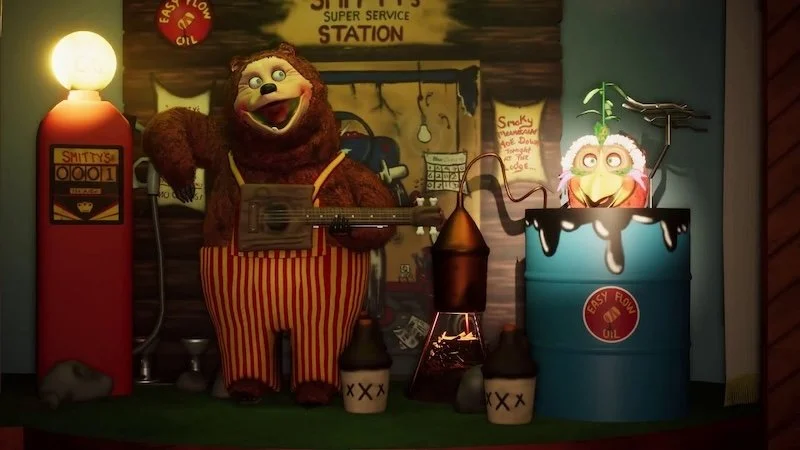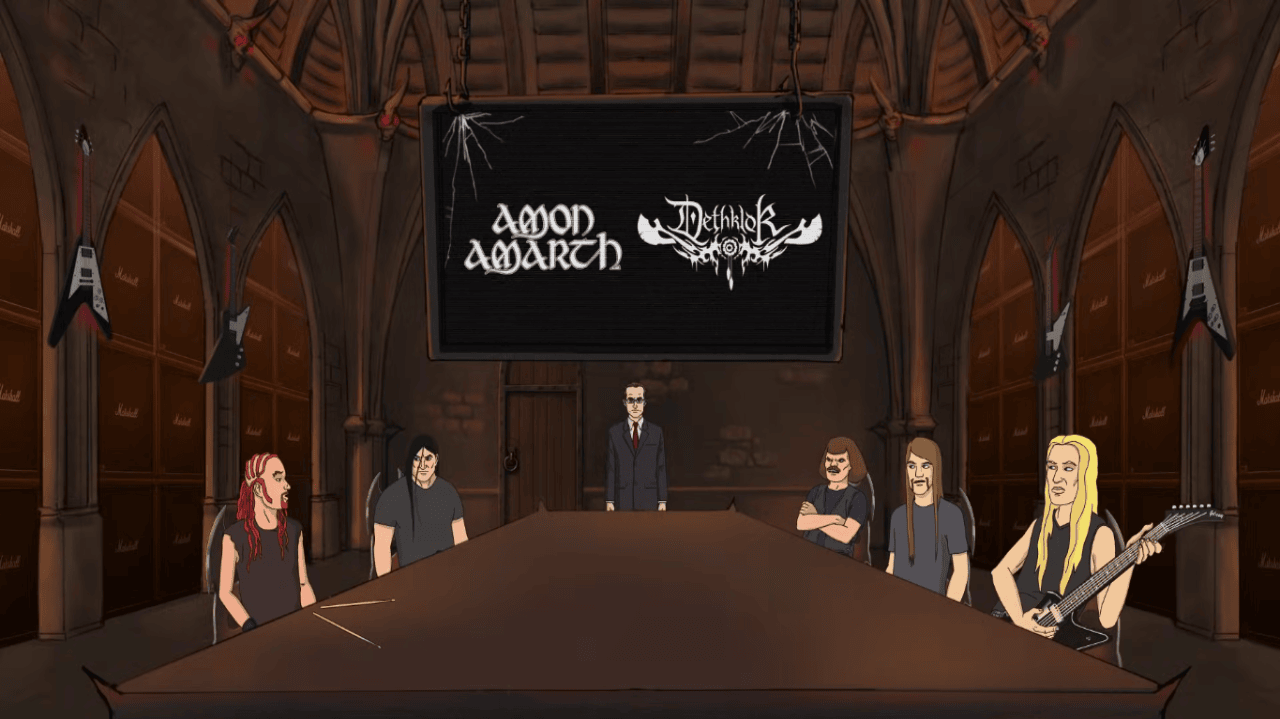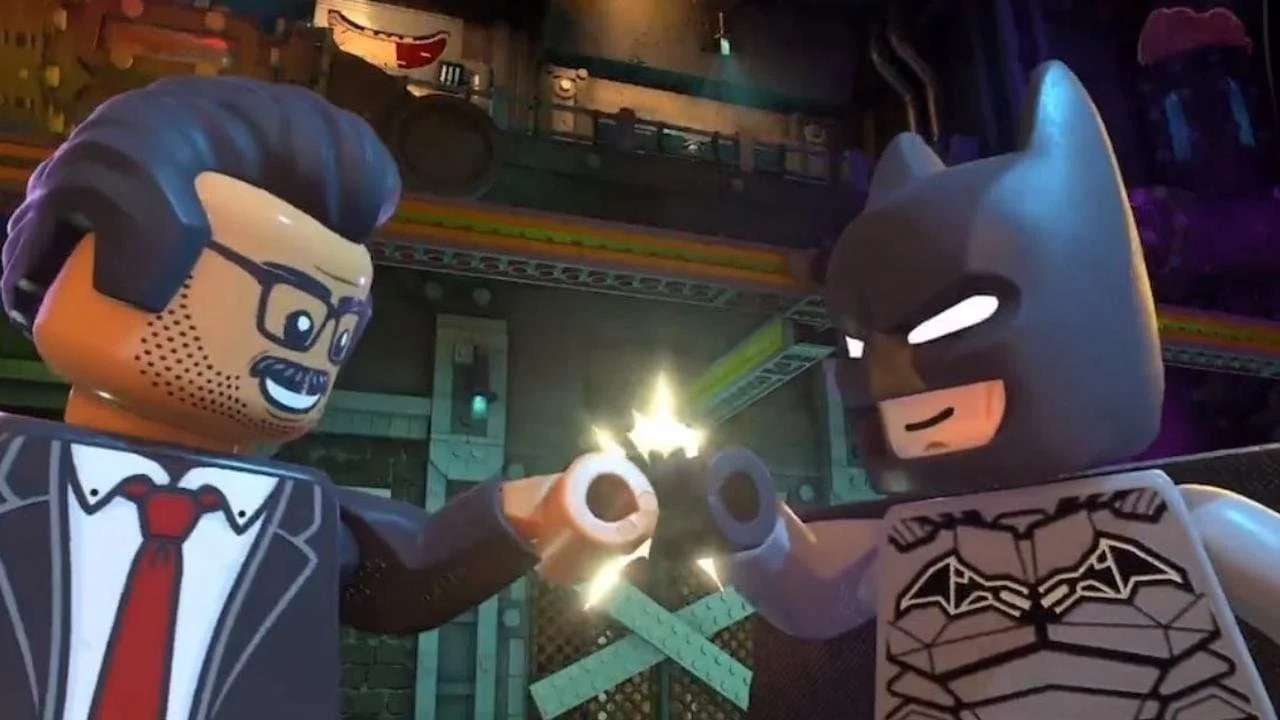The Rock-Afire Explosion: A Deep Dive Into The Showbiz Behind ShowBiz
Image Source: The Lost Media Wiki
It's a sad, sad state for fans of kitschy pizza animatronics, as Chuck E. Cheese, once the leader in this area of entertainment, has ramped up on removing the shows from their stores, supposedly leaving only one left in Northridge, California. However, if you were alive back in the 80s, then you may remember that the pizza rat/mouse was not the only name in town, as there was another arguably more successful pizza arcade chain called ShowBiz Pizza Place that used a very similar formula. They too had an animatronic band, and it was The Rock-afire Explosion. The story behind the creation of this electronic band has many twists and turns, so let’s dive into the showbiz behind showbiz.
Aaron Fechter Before The Rock-Afire Explosion
Image Source: Popular Mechanics
Aaron Fechter is credited with being the creator of The Rock-afire Explosion, and thus, his story is very much tied to the story of his creation. Fechter’s inventing career was driven by a desire to live on through his creations, much like Thomas Edison's popularizing the light bulb. When he began, his focus was very much on energy due to the energy crisis at the time, with his ultimate goal being “free energy.” However, he focused more on fuel efficiency during the early part of the 1970s.
RELATED:
“Back then, we had great big cars that were really guzzling the gas,” Aaron said in an interview with Culture Slate, “but I had had a scooter with a body on it—a Lambretta motorcycle—that got really high gas mileage…and I thought ‘You know what? I just need to make a modern version of that!’ Maybe a little higher horsepower and a three-wheel car…so that I can get past the legal problems of a car. So, with three wheels, it’s legally a motorcycle. Wouldn’t really even have to have seatbelts, certainly not airbags…wouldn’t have to have all that stuff that you have on a car, so that would make it cheap. So, it’d be cheap, highly efficient, and that would get us out of this problem we had in 1973, which was that we really didn’t have much gasoline to go around.”
Fechter would need funding for this project, however, and while developing this idea for a cheap, fuel-efficient vehicle, he would instead focus on solving a very unique to Florida: leaves in a swimming pool. With this in mind, he created the Leaf Eater, a device to clean leaves out of swimming pools. He sold his invention door to door, and it was during his door-to-door salesman days that he met a man by the name of Paul Zar. Fechter gave his usual spiel of “Hi. I’m Aaron Fechter. I’m an inventor and invented this leaf eater, and I’m gonna clean your pool with it right now and show you how great it is!” However, rather than ask Fechter to clean his pool, he challenged Fechter, claiming that if he was an inventor, he could invent anything. Fechter said he could, and it turned out that Zar worked for an off-shoot of Disney called Main Street Design and needed someone to invent a control system for an animatronic shooting gallery. Though he had not designed something like this before, Fechter accepted, and that got him into the entertainment side of engineering. Once he finished this project, he began work on a system to sync audio to an animatronic patriotic talking horse that told stories from American history. As he worked on this, however, he realized that they still hadn’t paid him for his work on the shooting gallery.
“Before I finished that, they had to pay for the other work I did, and they never did. So, I sued them for the $4,000 that they owed me, and I won my lawsuit, but a lot of other people sued them because they had just plain run out of money, and they went out of business.”
It was this experience that inspired Fechter to create his own business rather than work for someone else, and he founded Creative Engineering. His business focused on making his own brand of animatronics called “electronimation.” Fechter created a variety of characters such as a talking rabbit, a talking monster head, and other things. He soon became a mainstay of the International Association of Amusement Parks and Attractions (IAAPA) conventions. It was during the 1977 convention that he met Atari founder and Chuck E. Cheese creator, Nolan Bushnell. Bushnell approached Fechter with an offer to buy his animatronic characters for his chain of restaurants, impressed by the talking bear Fechter had on the showroom floor. Aaron declined, however, due to him worrying about Bushnell reverse engineering his characters.
Image Source: Video Game Pavillion
“I prefer to do business—especially back then—with someone who is not mechanically or electronically confident who really needs me to do it, who doesn’t want to do it themselves…Besides seeing that he had the ability to copy my work, I felt like he had the character to do it. That was his style…because Nolan Bushnell, he came from a carnival background, and carnival people are different from regular people, and they’ll tell you that. For example: The guy I built the Whack-a-mole for. He called himself a carnie. He says ‘We’re different from you, Aaron…There’s two kinds of people in the world. There’s carnies, and then there’s suckers.’...I didn’t forget it…so in 1977, when I learned a little about Bushnell, and I knew that he used to be a carnie…I said…'Ok, so, I’m the sucker, and he’s the carnie. So I wasn’t gonna let him take advantage of me, and that’s why I declined to do business with him.”
Image Source: YouTube
Bushnell wouldn’t give up, however, and in 1978, Fechter brought in a brand new show called The Wolf Pack 5. This show consisted of the characters The Wolfman, Fats, Dingo Starr, Beach Bear, and Queenie the Fox. Impressed by the show, Bushnell offered to buy his company, but once again, Fechter declined his offer due to him only offering the young inventor stock options in the new company rather than cash.
However, he also attracted the attention of Bob Brock, who in the summer of 1979 had recently signed a deal to open 280 Chuck E Cheese restaurants (then known as “Chuck E Cheese’s Pizza Time Theater”) across the country. Bob Brock was the owner of a large chain of Holiday Inn hotels at the time, so it was a huge deal for the then-fledgling pizza chain to team up with someone of Brock’s caliber. Aaron Fechter caught wind of this deal and used it as motivation for his showroom floor offerings at the 1979 IAAPA convention. Not only did he take The Wolf Pack 5 but also a brand new show called The Hard Luck Bears. Though Bob Brock did not show up at this convention, he did have two of his scouts, Ralph Kanard and Andy Waylin, show up and report back to him about Fechter’s exhibit. The scouts were blown away but also upset because they had thought Bushnell was the only one producing animatronics outside of Disney. Brock had based the signing of the deal on that fact. He attempted to cancel his contract with Bushnell, but Bushnell did not allow the agreement to be nullified. Brock ignored this and entered an agreement with Fechter to build a completely new restaurant chain with a similar concept to Chuck E Cheese’s Pizza Time Theater called ShowBiz Pizza Place. Unfortunately for the fledgling restaurant, Pizza Time Theater Inc., the company behind Chuck E Cheese’s Pizza Time Theater, sued Bob Brock for breach of contract and theft of trade secrets, to which ShowBiz Pizza filed a countersuit, claiming misrepresentation. The lawsuit was settled out of court for $50 million and a portion of Showbiz Pizza’s earnings, but in the meantime, the era of Showbiz was just about to dawn.
The Early Days Of ShowBiz Pizza Place And The Birth Of The Rock-Afire Explosion
The first Showbiz Pizza Place opened on March 3, 1980, in Kansas City, Missouri. Initially, it used The Wolf Pack 5 show, with Queenie being changed to a mouse named Mini Mozzarella. The act was soon changed to The Rock-afire Explosion, and it had many links to both The Wolf Pack 5 and another one of Fechter’s previous shows, The Hard Luck Bears and the Bear Country Jubilee. Chet Faddigans from the Country Bear Jubilee and Billy Wilbur from the Hard Luck Bears became Billy Bob, Fats Gorilla became Fats Geronimo, Dingo Starr became Dook LaRue, Beach Bear pretty much remained the same, The Wolfman became Rolfe DeWolfe with a new puppet “sidekick” called Earl Schmerle (which was inspired by Fechter’s real-life friend Billy Bob who often had an Animal puppet with him), Gooney Bird from The Hard Luck Bears became Looney Bird, and Mini Mozzarella became Mitzi Mozzarella. When the show first began production Fechter voiced all of the characters except for Dook LaRue and Fats Geronimo, who were voiced by Duke Chupetta and the late Burt “Sal” Wilson respectively. However, Shalisa Sloan was soon brought in at only 11 years old to voice Mitzi, and Rick Bailey took over voicing duties for Beach Bear. Rick Bailey initially started as a recording engineer and programmer for Creative Engineering.
“There was a local…I guess you would call them voice teacher [Ron Feldman], but he was just generally…he would, y’know, go to clubs and see people who were talented, and, y’know, kinda…hook them up with other musicians who were more their age of that caliber.” Bailey said in an interview with Culture Slate, “So, when he spotted somebody who he thought was good…y’know, we would make friends with other people that he knew, and Aaron was one because he was taking vocal lessons from Ron Feldman, and Aaron didn’t—you know, he was programming all of the Showbiz Pizza characters by himself, and it was just becoming to much to do on his own. So, he hired somebody, and then he needed more help because even two of them weren’t enough, so eventually he wanted someone who could do that, and he wanted somebody with rhythmic skills who was musical in general. So I was about twenty, twenty years old, so I went to work for him as a programmer of the animals.”
Initially, that, in addition to being the recording engineer, was his main responsibility. However, Fechter soon heard Bailey play and sing and instantly wanted to show the others, as Bailey recounts:
“Aaron heard me sing, and I don’t know if you know the Warner Brothers frog…The Warner Brothers frog would only perform for the one person. So, when the guy…he wanted to promote the frog and put him in an act, and whenever he put him in the act, the frog did nothing. So, he just seemed like a crazy guy…That was kinda like with Aaron, when he heard me sing, he went and got Burt and a couple of other musicians that were working there and said ‘You gotta hear this guy sing!’...He goes ‘Okay, come on in and just listen to this guy sing and play,’ and I was playing piano…and of course I was on the spot, so I just kind of froze up like the Warner Brothers frog, and they’re looking at Aaron like he’s nuts…like ‘This guy’s not very good at all.’...Eventually, once I get comfortable with the other guys, the other musicians, and once they got comfortable with me, everything changed because I was not intimidated, and I wasn’t doing a recital. I don’t do recitals well.”
Image Source: YouTube
So, the quintet of talent was set. Aaron Fechter would voice Billy Bob, Rolfe De Wolfe, Earl Schmerle, and Looney Bird, Burt “Sal” Wilson would voice Fatz Geronimo, Shalisa Sloan would voice Mitzi Mozzarella, and Rick Bailey would voice Beach Bear. The group would perform often improvised or slightly scripted skits that accompanied its mostly classic rock/oldies format, with some then-contemporary pop tunes sprinkled in here and there. Initially, Fechter made most of the decisions regarding what songs to play, but he also let each band member create their own setlist. The repertoire of this animatronic band was quite eclectic, ranging from covers of 50’s Rock and Roll to even the medley on the backside of The Beatles’ Abbey Road album. There would even be themed nights or promotions, such as the Colander Head movement that led to the first year the restaurant made a profit. Things began pretty smoothly between Creative Engineering and Showbiz, but an important event was on the horizon that would act as a turning point for the restaurant chain.
The Merger Of Pizza Time Theater And ShowBiz Pizza Place
Image Source: Flickr
Both Pizza Time Theater and ShowBiz Pizza Place were battling for dominance. Each chain expanded with new stores opening pretty much next door to each other. In terms of Showbiz and The Rock-afire, advancements to the animatronics were even being developed, such as a version of Dook LaRue that could actually play the drums and a version of Mitzi Mozzarella with expanded movements. However, a huge draw of both chains was the arcade games that were attached to them. This would turn out to have a huge impact on the success of both companies with the video game crash of 1983. While both companies would struggle, it was Pizza Time Theater that filed for Chapter 11 bankruptcy in 1984. Despite still being afloat, Showbiz Pizza Place was still struggling due to the effects of the crash and still owed money to Pizza Time Theater. So, Showbiz Pizza Place acquired Pizza Time Theater, and the two merged to create ShowBiz Pizza Time Inc. Aaron Fechter, however, did not agree with this decision. He had a 20% stake in the company at the time, but he ultimately had to sell his stock for the deal to go through.
With the new company came changes to daily operations. While both Pizza Time Theater and ShowBiz Pizza Place operated independently, Showbiz Pizza Time was slowly trying to depend on Creative Engineering less and less, especially once Dick Frank became CEO. There were some slight issues between Fechter and ShowBiz Pizza Time. These included allegedly not meeting the deadlines set by SPT, though Fechter denies this. He stated that there was a target to have a showtape out every three months, but they knew that was an unrealistic goal. Despite this, Showbiz Pizza Time started creating their own showtapes with their own sound-alike voice actors. This began the struggle for control between CEI and SPT, with both teams often competing with one another. This came to a head when allegedly, CEI was celebrating the creation of a showtape, and during the celebration, one of the employees accidentally erased the showtape. Fechter, however, remembers it differently.
“There was no party.” He recounted, “You know what there was? There was a celebratory pizza that we ordered when we were taking a break. It was programming the show, and it was almost finished. It was perfect! It was the most unbelievable show I ever programmed, and it was gonna show off my programming ability with one of the greatest shows [showtapes] we had ever created, and it was just magnificent one end to the other beyond anything I could describe. It was the perfect show.”
“And I had my dad there, and Billy Bob [Aaron’s friend] was there, and I had a software engineer named Ron there…and maybe one other guy, but that was it—or maybe Kathy was there, my assistant programmer. That was it. It wasn’t like we had a party, where lots of people were there, and we were celebrating, and we were drinking. There was no alcohol there…We were having a good time. We were happy. It was amazing. We knew it was gonna blow Dick Frank away. He was coming tomorrow, and we just had the world on a platter…While they were finishing up their pizza, I was making backups of all this incredible data I created…but I was stupid…I was backing up the data that was in this computer on the floppy disks. Now, the mistake I made was not backing up onto new floppy disks. I was backing up onto my old backups, because every time I changed anything in the show—if I just fixed a light, if I just fixed a mouth—anything I did I backed it up...I put it on a disk, and I had a stack…maybe 20 disks high with the top disk being what I called the ‘smartest’ disk, and the bottom disk being the ‘stupidest’ disk…I shouldn’t have done this, but I thought ‘Okay, I want all my disks to have the latest data on them.’ So, I copied the data onto all of those disks—all 20 of them.”
“…but something must have happened to the data before I started copying it, because it was all corrupted—it was gone—and so I had erased the data off of all the disks and replaced it with garbage, and to Ron, my software engineer who was there, I said ‘Ron, look what I did…Ron, is my data gone? Is the show gone?’ It was gone…Now, who knows? Would it have made a difference with Dick Frank?... I started over, and all I got done that night was the lights…but it would take me another two weeks…two or three weeks…to get back all that data and do as good of job if I could…So, I knew I was going to have to explain to Dick Frank what happened, and I called it a party at one point in some interview…but really, it wasn’t a party.”
Rick Bailey, however, does remember partying at Creative Engineering, but he isn’t sure that is what ultimately caused SPT to take over programming and relegate CEI to just the audio portion of the shows. Ultimately, however, there were rifts between corporate SPT and CEI. SPT wanted full control of The Rock-afire Explosion, but Fechter was not willing to give that away, even taking away ShowBiz Pizza’s exclusivity of The Rock-afire by installing shows in other restaurant concepts. This was a constant “battle,” but Fechter calls it simply a seven-year period in which they stopped relying on each other. He even stepped down as entertainment director around the time Showbiz and Chuck E Cheese merged.
Concept Unification And The End Of ShowBiz Pizza Place
Image Source: ShowBiz Pizza Wiki
Though he describes it as an amicable separation with no real “severing of ties,” there did come a point of no return in 1989 when they asked Fechter to sell the rights to The Rock-afire Explosion for essentially nothing.
“They wanted a package deal with nothing for the copyrights.” Fechter explained, “There was a package deal with Gene Cramm, who was the guy who was negotiating with me. He wanted to buy the rest of my inventory. I still had a bunch of shows…I had 50 or 60 Rock-afire Explosion shows still in the crates in my warehouse in Orlando. Those shows were ‘given’ to me back in the mid 80’s—around ‘85—when we signed a contract that allowed Showbiz Pizza Place…to do certain things that they had not been allowed to do before…It was some kind of release, and in that release, I also got some cash. That was back in 1985. I got my cash from the sale of stock. Not the sale of copyrights, not the sale of shows, not sale of equipment, not sale of showtapes.”
“By 1989—or ‘88, whatever it was—, Gene sat down. He opens up his briefcase…and he brings out the deal, and the deal was to buy my inventory—that other 50 shows—, and he was offering me $40,000 a piece for those shows. Well, at that point, I thought they were worth more…After all, it costs $115 or $120,000 to build them. I didn’t think that they would be selling for that low. Even if it took me longer to sell them, I thought I could sell them for $60, $70, $80, $100,000 at least. So, I felt like his offer was low…But wrapped up in his deal, was that I would give him the copyrights to the characters as well, so I would have been completely out of the Rock-afire business. He would have gotten all my shows, he would’ve gotten the copyrights, he would’ve gotten the rights to do whatever he wanted to with my characters, and you know, if I had done that, the characters would never be The Rock-afire Explosion again. The way they still are. The way you know them. There wouldn’t be any for you to see anywhere…There would be no further Rock-afire Explosion. They’d mix and match, they’d probably put characters from Chuck E Cheese and put them in there…”
“Gene offered me $2 million for the shows and nothing for the copyrights, and I said, ‘Well, what do I get then? What do I get for the copyrights?’ He says, ‘Well, you don’t get any money, but at least your characters will live on, because if you don’t sell us the copyrights, we’re going to take all your characters off the stage, and Billy Bob will die…Fats will die. Dook will die. They will all be dead.’ I said ‘Okay, I accept your challenge.’ So basically, I just walked away from that deal, and you know what I had in the back of my mind?... I’m an entertainer. I like entertaining. I love singing for the characters, and you know, I’ve used up all my voices. I might have a few more voices in there somewhere, but Billy Bob, Looney Bird, Rolfe and Earl, those are the easy ones…There might be a few other ones I got, but I thought, ‘You know, if I move on, let’s say I create a new show…with new characters, my new characters are gonna sound like Billy Bob and Looney Bird and Rolfe and Earl because that’s me! That’s what I sound like…So you know what? I think I’ll sell those shows for more than $40,000 a piece AND keep the copyrights AND pursue my dreams of The Rock-afire Explosion having a hit record someday, because you know what? I had a lot of money. I didn’t need money in 1989. I had a lot of money leftover. I didn’t spend my money that I got when I sold my 10% of ShowBiz Pizza Place; it’s still in the bank.”
So, Concept Unification happened. Fatz Geronimo became Mr. Munch, Mitzi Mozzarella became Helen Henny, Beach Bear became Jasper T. Jowls, and Rolfe De Wolf became the man himself, Chuck E. Cheese. Billy Bob and Earl were not used and were removed from the stage. During the period when the animatronics were being worked on, a show tape featuring only Rolfe and Earl called “The Rolfe and Earle Show” was shown, featuring clips from the music videos for some of the best showtapes while giving hints of what the rebrand would entail. However, this did not mean that The Rock-afire Explosion concept was over.
The Rock-Afire Explosion In The 1990s
Image Source: YouTube
The Rock-afire Explosion still existed in various other restaurants besides Showbiz such as Pistol Pete’s and Billy Bob’s Wonderland, and showtapes were still produced for those clients and more. New developments in the technology behind the Rock-afire were also seen during this period, such as the show selector and video synched with the audio. The biggest development was the creation of The New Rock-afire Explosion using the new “mijin” line of animatronics. These animatronics were smaller and featured more advanced movements. A new chain of restaurants called Looney Bird’s also opened, but it was shortlived. Despite this, the band was far from its glory days. The company had to grow smaller and smaller until Aaron Fechter was its sole employee. However, it would soon see something of a revival in the new millennium.
New Millennium, New and Old Fans
Image Source: YouTube
Though Showbiz Pizza Place and The Rock-afire Explosion were no longer in the public eye like they once were, there were still fans of the chain and the band that once graced its showroom. One such fan was a man named Travis Schafer. Travis had been a fan of ShowBiz and its animatronic band since he was four years old, and though he drifted away from this interest for a bit as he grew older, he was drawn to it again when he discovered the internet as a senior in high school. Frustrated by the lack of anything on the internet regarding Showbiz, he took it upon himself to create ShowBizPizza.com in 1999. The website serves as a hub for community and information regarding both Showbiz Pizza Place and Chuck E Cheese’s. As the website grew, Travis Schafer reached out to Aaron Fechter and made him aware of the growing fandom sometime in the early 2000s, which at the time consisted of people who had grown up with Showbiz. Initially, Fechter was honored by this. It was through this that he first learned that people still cared about his work. However, tensions soon grew between some of these fans and Fechter.
“I was being abused as much as I was being honored.” Fecthter recalled, “I thought ‘Woah, this is weird. I wouldn’t think thay I would be abused by these people.’ I would think that they would honor me the way they seem to be, but then the abuse started, and then that’s when I realized ‘You know what it is? They’re children. They’re children having fun at my expense, and so I’ll just stand over here, let you guys have your fun.’”
This was the state of the fandom from about 2000-2004, and it gradually grew outside of what Fechter called “that toxic website.” People even wanted to acquire the animatronics for themselves. Some people even made their own showtapes. One such fan was Chris Thrash. Thrash bought a Rock-afire Explosion show from Fechter himself and began programming the animatronics to modern songs. He then uploaded recordings of these showtapes onto YouTube, and these videos soon blew up, growing the fandom even more. This inspired Fechter to upload recordings of new shows on YouTube, with the help of fans such as Chris Thrash and another fan by the name of David Ferguson. Ferguson and Fechter initially worked together on a new controller called Program Blue. However, the deal soon fell apart. It was during this time that tensions and feuds seemed to be rampant in the fandom, including one with the voice of Fatz Geronimo.
“I wanted to try to hold onto Sal [the voice of Fatz Geronimo] for as long as I could,” Fechter explained, “so, I did. Out of my savings…that I was budgeting to live on for 20-30 years—I had to because I had no idea when I would make any more money…a portion of that money was budgeted to pay Sal so that we could stay together, and then at some point, there was just no more work, and at that same point, Sal had become popular on a radio show…As I was using Sal less and less and paying him less and less, I still didn’t love him less and less. In fact, every time I had a new opportunity, I brought Sal in on it…I was no longer able to pay Sal any money, and Sal was a popular radio character whose name was then Bubba ‘Whoop-ass’ Wilson, and everyone loved him on the radio. This was his new career after being Fatz…Well, he developed a feeling. He didn’t trust my love for him. Something happened…and he thought the same thing that a lot of my talented employees thought…where they thought that I had unfairly benefitted from their talent and not rewarded them, not monetarily, enough…The Rock-afire Explosion has not become a cash cow again yet…they didn’t like how long it was taking me to make it again, and people just decided, Sal among them, that I had benefitted unfairly from their talent. And they didn’t like me anymore for that reason.”
Image Source: YouTube
So, from 2008 to about 2020, Aaron Fechter added Fatz Geronimo to his list of roles, but the other cast members, Rick Bailey, and Shalisa Sloan James returned to their roles when Fechter reintroduced the band in 2008. The band was also featured alongside several touring acts such as CeeLo Green and Fall Out Boy. It was even the subject of a documentary in 2008 titled The Rock-afire Explosion. The animatronic band was getting some semblance of relevance again, but it was not without its controversy.
When the initial revival occurred, Fechter realized that most of his fans were all adults. Though the Five Nights at Freddy’s franchise would soon introduce a new generation to the concept of animatronic bands, the vast majority of The Rock-afire Explosion fanbase in the mid-2000s until some point in the 2010s were adults who grew up with The Rock-afire Explosion at Showbiz. So, with this knowledge, Fechter decided to use his animatronic band as a platform for social and political issues. One of the earliest examples of this more mature era for the band was the original song “I Ain’t Gay,” which features Billy Bob Brockali saying that he is straight but has yet to kiss a girl and is just waiting for the right one. The adult language was even used in their reworked cover of CeeLo Green’s “F**k You!” titled “Poo on You,” though obviously the language was also present when they accompanied Green and were synced up to the actual song. However, perhaps most controversially, Fechter released a reworked, modernized, and more right-leaning cover of the song “Eve of Destruction,” which features puppet Earl Schmerle singing the line that features a derogatory term that will not be published in this article. Fechter has also been very possessive over his copyrights and intellectual property over the years with him often refusing to do business with those who use third-party controllers or masks. However, most of this wouldn’t come to a head during the early days of the revived fandom but would be seen more and more as it grew.
The Rock-Afire Explosion In Today’s Fandom Culture
Image Source: Pintrest
The video game franchise Five Nights at Freddy’s was a smash hit in the 2010s, and with it came people flocking to its inspirations: ShowBiz Pizza Place and Chuck E. Cheese’s. For the fanbase of The Rock-afire Explosion, this meant that the fandom was expanding and growing younger. More and more fanart and fanfiction would be published featuring the characters. Those who had access to the animatronics made more and more custom showtapes. However, while Fechter appreciated the new fandom, the 2010s saw him feud more and more with his fans and business partners. In 2013, Fechter and Billy Bob’s Wonderland owner Rex Donahue would have a massive fallout. Retrospectively, Fechter attributes this to effects relating to age and dementia, but at the time, Fechter came down to the Barboursville, West Virginia restaurant to see his characters lifeless and in shambles. Though they had recently acquired a new control system from Fechter, there were still various repairs needed on the animatronics. Donahue said Fechter wouldn’t get a red cent from him until the entire show was overhauled, which Fechter balked at. He then threatened Fechter and his girlfriend and said that the police were called on him, though no police report was ever found. Thankfully, however, things have been patched up upon the death of Donahue, and Billy Bob’s Wonderland now being under new management.
Image Source: YouTube
As the fandom grew, they experimented with new ways to express their love for these characters. In August 2020, an animatronic simulator called Rock-afire Replay was developed and released by The 64th Gamer. Around this same time, Fechter was also working with someone on his own simulator. Fechter contacted 64th Gamer and told him that he was interested in working with him on his simulator and wanted to find a way for them to make money off of it, with Fechter interested in getting a licensing fee for his characters. 64th gamer, however, never responded directly to Fechter and decided to pull the plug on the project in 2021 after Fechter began taking down videos of showtapes created using the software, fearing litigation. Simulator programs still exist but are mostly private, especially after CEC Entertainment sent a Cease and Desist to a Chuck E Cheese-focused one called Reel to Reel. Fechter has been more lenient, however, and allows these videos to be published if they are sent over to him for his approval. As of this writing, Fechter has resumed work on a new simulator program, one that would even allow people to use it to program their own shows for the actual animatronics
Though the Rock-afire Explosion remains popular, Fechter is not very well-liked in the community, and that’s something that he has had to learn as well as this fandom grew, with him saying:
“People love the characters, not me. I used to think that it meant they loved me but it doesn’t. They don’t understand that I am that guy on your back [referring to fans who tattoo RAE characters on themselves]. I am that guy when you turn on your show, and you hear Billy Bob singing. That’s me. That’s why I thought they loved me, but they don’t love me. They love the character. They absolutely don’t associate me with the character. But I am the character. I am that guy.”
Indeed there is something of an unspoken rule within the fandom to not necessarily associate The Rock-afire Explosion with its creator, and this has caused some tensions to rise with other prominent figures in the fandom and Fechter, particularly those who exhibit his work without a licensing agreement. Despite this, Fechter continues to work with fans and clients who are willing to work with him on his terms.
The Death of Burt “Sal” Wilson and The Rock-afire Today
Image Source: YouTube
On December 28th of last year, Burt “Sal” Wilson, the voice of Fatz Geronimo and one of the co-writers for the band, passed away at the age of 68. The news hit the fandom hard, but it especially hit those close to him. Fechter had only recently reconnected with Fatz and had planned on doing even more shows with him.
“I was nothing without Sal.” Fechter stated, “Sal came back to me around 2018, 2019, and he said he appreciated our life for each other, our love for each other, and he wanted to bury the hatchet, and I was very happy to do so because I didn’t have a hatchet for Sal. Never, did I have a hatchet for Sal, and now, we were able to communicate again…Apparently, Sal had a lot of problems with his life during those years that I wasn’t with him. I wasn’t there to give him guidance through those problems, and the people that he was working with didn’t love him like I did, I can tell you that, and they let him…they let him deteriorate…They are the ones who used him unfairly. They were the ones who cut out the golden chicken to steal the eggs and then let Sal die. So, Rock-afire will never be as good as it was with Sal, but we have to pick up the pieces and continue on, but it will never be as good.”
“When we met, I was about 21 and he was maybe 28.” Rick Bailey recalled, “He was a thin guy with a lot of energy and very frenetic…was very excited, very excitable, and we were both that way. We really enjoyed making music together and writing together. So, that part was really fun…He hasn’t been well for a while. We drifted apart pretty seriously over the last seven years or so…It’s a little hard to remember what we were and then how things ended up…Burt had some troubles keeping his life together…We all knew that, and so it wasn’t a huge shock other than the fact of the reality of ‘Well, we’re never gonna see him again.’”
Bailey also stated that Wilson’s physical and mental health had been declining for some time towards the end of his life, stating:
“...his enthusiasm and spark, he kept that for most of his life, but it got kinda diluted by…best I can say is life choices. It would dim his light. It’s difficult…as a friend, you try to support them, but then if that support turns into…you know…gets abused or taken advantage of, at a certain point, you kinda have to pull yourself out even though you still care for that person.”
Fans and friends alike posted various tributes to Wilson, and though Fatz will live on within The Rock-afire Explosion, it won’t be the same.
As for the state of the band today, Fechter is still continuing to use the brand and work on new projects, planning to open a museum of sorts for his animatronics with them as a feature. Though animatronic entertainment outside of Disney may seem dead, it’s still very much alive if you look in the right places. The Volvo Auto Museum recently reached an agreement with Fechter to exhibit the show after previously being barred from doing so due to them using a third-party control system, and fans have their own public and private exhibitions of these characters. As long as people are willing to watch and listen, the animatronic band will play on, even if their counterpart dies out.
READ NEXT:
Source(s): Interview with Aaron Fechter, Interview with Rick Bailey, ShowBiz Pizza Wiki, DCist, Animatronic Programming Games Wiki, Cheese-E-Pedia, YouTube, ShowBizPizza.com

